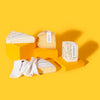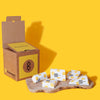cheesegeek
How To Use A QR Code with TheCheeseGeek.com
A QR code is a 2-dimensional barcode that stores data in either plain text, URL, or encoded format. The name QR stands for "Quick Response," as it was originally designed by the automotive industry to track parts during the manufacturing process. It's now used in many other industries, including marketing, retail and social media.
QR Codes are one of the simplest and easiest to use forms of augmented reality. Anyone with a smartphone can generate QR Codes and utilize them for various purposes.
How We Generate QR Codes?
There are many ways to generate QR codes, including online generators, smartphone apps, or dedicated hardware that you can buy. If you own a smartphone, the best option for generating a QR code is to use a free app or online generator.
All you need to do is search the website that offers QR code generation and paste your website's or app's link there and click on the generate link. This will automatically generate the QR code that you can use anywhere.
o2ohub.com is one of the best QR code generator websites that we use for our promotional flyers, and every other QR Code needs. All you need to do is add relevant information in the box, and it will generate the code without even pressing generate button. You can customize your QR code as well with different design options available on this website.
Uses of QR Codes
There are various uses of QR codes. Some common uses include:
Add more information to an image or any other type of content for marketing purposes. Track inventory, donations, or anything you can imagine. Store product information for sale on online marketplaces like Amazon and eBay. Share contact details with someone else. Scanning the code will direct users to your website or start an app.
For marketers, one of the most popular uses for QR codes is to generate high-converting leads for their business. Proper use of QR codes will help users with smartphones scan the code quickly and visit your websites, where they can then convert into customers by signing up or purchasing something.
For example, if you want to scan the QR code of TheCheeseGeek.com, then all you need to do is open the camera of your mobile phone and scan the code. It will show a popup. You just need to click on it, and it will open the information stored on that QR code.
Benefits of QR Codes
There are many benefits to using QR codes. Some of the most significant benefits include :
- It's free and easy to use.
- Anyone can generate a QR code quickly.
- Allows you to add more information to an image or content with just a click of a button.
- Allows users to quickly access a website or start an app.
QR codes can be utilized in many different ways for any purpose, and the benefits of using QR codes far outweigh any costs associated with them. For example, we are using QR codes very frequently on our flyers, pamphlets, and brochures because this gives us ease to get orders from our customers. All they need to do is scan the QR code and place their order.
The best way to learn about QR code use is to experiment and try out what works for your business and personal pursuits.
Different types of QR Codes
QR codes come in different shapes and sizes, including square, rectangular, circular, diamond shape, and even heart shape.
The encoding scheme is also different, which means that some QR codes are black-and-white while others can include colors or hidden messages. The most common types of QR codes are 2D matrix barcodes that offer more information than just one-liners.
What does a QR code look like?
QR codes are square in shape and look like any other square 2D barcode. The encoding scheme dictates the color of each grid cell. For example, if the code uses black-and-white colors, then it will have one dark square and three lighter squares forming a matrix. Each grid cell also has an alphanumeric string which means that it can encode data using characters or numbers.
The QR code contains human-readable text, encoded URL, and email address. It's also capable of encoding date and time information. Any type of data can be added to a QR code, including images, audio files, video files, and just about anything else you can imagine.







